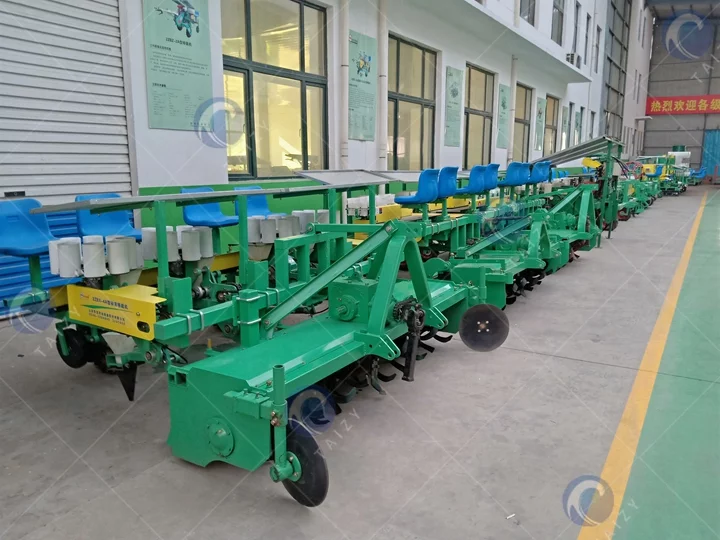Quy trình làm việc của máy cấy cây trồng
các máy cấy cây tự hành đại diện cho đỉnh cao của sự đổi mới trong nông nghiệp, hợp lý hóa quy trình cấy ghép cây con phức tạp để nâng cao hiệu quả công việc tổng thể.
Hãy cùng đi sâu vào nguyên lý hoạt động của nó, mổ xẻ các thành phần chính giúp chiếc máy này trở thành một lực lượng biến đổi trong nền nông nghiệp hiện đại.
1. Các bộ phận chính của Máy cấy tự hành:
Các bộ phận cốt lõi của máy cấy cây tự hành bao gồm cốc đựng cây giống, chỗ ngồi, khay, khung, thiết bị cấy và bánh xe. Cấu trúc của nó được thiết kế có chủ đích để đơn giản, nhấn mạnh tính hiệu quả và dễ vận hành.

2. Động cơ xăng đẩy:
Trung tâm của máy cấy ghép tự hành là động cơ xăng, đóng vai trò là động lực mạnh mẽ đẩy máy về phía trước. Động cơ này đóng vai trò như một cỗ máy phát điện, chuyển đổi nhiên liệu thành động năng, cho phép di chuyển liền mạch trên sân.
3. Thiết kế lấy người vận hành làm trung tâm:
Thiết kế xoay quanh sự thoải mái và hiệu quả của người vận hành. Nằm trên ghế, người vận hành sẽ điều khiển chuyển động của máy. Cấu trúc được thiết kế công thái học đảm bảo môi trường làm việc thoải mái, cho phép người vận hành tập trung vào việc đặt cây con vào cốc một cách chính xác.
4. Tích hợp khay ươm và cốc:
Cây con được đặt vào khay ở vị trí chiến lược trên máy. Người vận hành ngồi ở vị trí được chỉ định, lấy cây con từ các khay này và cẩn thận đặt chúng vào bầu đựng cây giống. Bước này rất quan trọng cho quá trình cấy ghép tiếp theo.

5. Cơ chế cấy ghép:
Cơ chế cấy ghép là trung tâm của hoạt động. Khi cây con đã ở trong cốc, thiết bị cấy ghép sẽ hoạt động. Nó di chuyển các cốc hạt giống vào đất một cách chính xác, đảm bảo mỗi cây con được trồng ở độ sâu và khoảng cách tối ưu. Quá trình cơ giới hóa này đẩy nhanh đáng kể quy trình cấy ghép, giảm thiểu lao động thủ công.
6. Tích hợp liền mạch các bánh xe:
Bánh xe đóng vai trò quan trọng trong khả năng di chuyển của máy cấy cây tự hành. Khi động cơ xăng đẩy máy về phía trước, các bánh xe được thiết kế tốt đảm bảo khả năng di chuyển trơn tru trên sân. Sự tích hợp liền mạch này cho phép di chuyển hiệu quả và chính xác, góp phần nâng cao hiệu quả chung của quá trình cấy ghép.
Phần kết luận
Tóm lại, nguyên lý làm việc của máy cấy tự hành xoay quanh sự đơn giản, hiệu quả và thiết kế lấy người vận hành làm trung tâm. Bằng cách khai thác sức mạnh của công nghệ, kỳ quan nông nghiệp này là minh chứng cho sự phát triển của việc cấy ghép cây giống, mở đường cho việc tăng năng suất và thực hành canh tác bền vững.